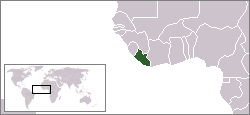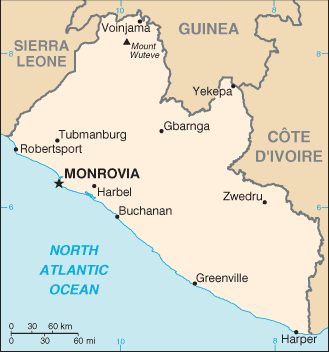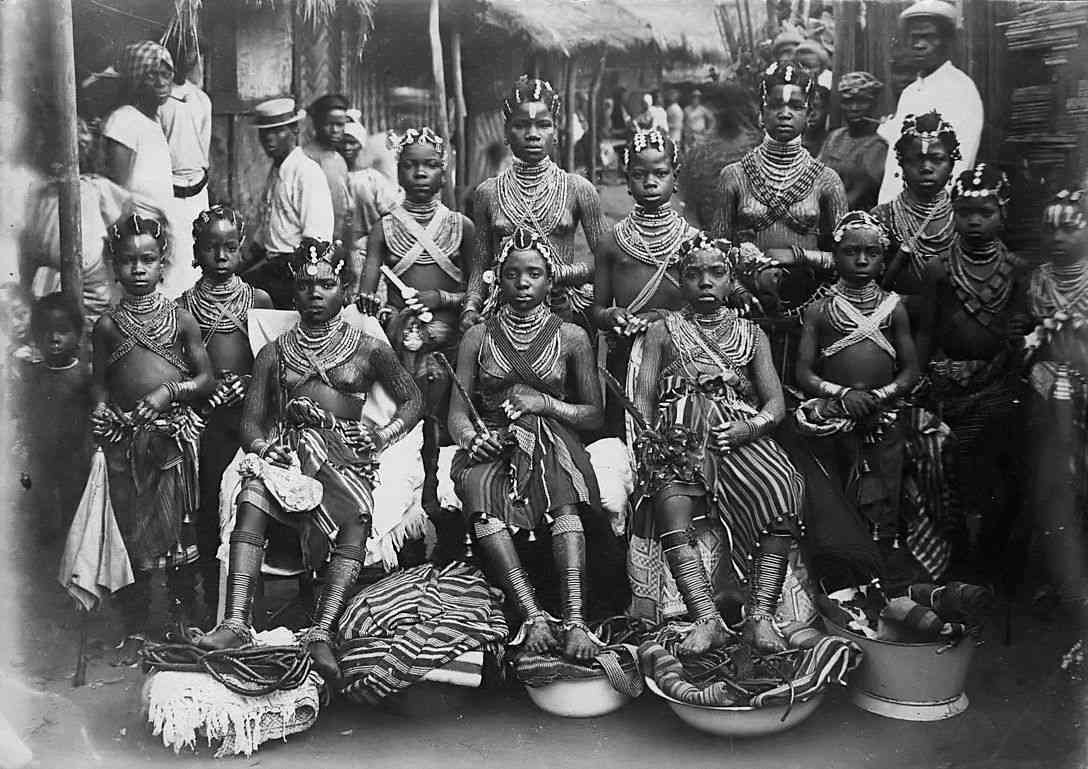
Liberia is a West African country bordering Sierra Leone, Guinea and Ivory Coast. It is bordered by Sierra Leone to the west, Guinea to the north, and Côte d'Ivoire to the east. The Liberian coastline consists mostly of coastal Ike forests, while the densely populated interior consists of forests that open onto a plateau of drier meadows. The country owns 40% of the remaining upper Guinea rain forest. Liberia has a hot tropical climate with heavy rain during the rainy season between May and October and the harsh winds of Harmattan for the remainder of the year. Liberia has an area of 111,369 km2 and is home to about 3.7 million people. English is the official language, while more than 30 indigenous languages are spoken within the country.

Liberia is one of only two modern countries in sub-Saharan Africa without roots in the European conflict over Africa. Beginning in 1820, the region colonized freed slaves from the United States with the help of the American Colonial Society, a private organization that believed that former slaves would gain more freedom and equality in Africa. It is the origin of the country’s name Liberia, which is derived from the word Liberty, which means freedom. The slaves freed from the slave ships were also sent there instead of being sent back to their home countries. In 1847, these colonists established the Republic of Liberia and established a government modeled after its counterpart in the United States and named the capital Monrovia after James Monroe as the fifth President of the United States and a prominent supporter of colonialism. The colonists, also known as the Liberians of America, monopolized the country's political and economic sectors even though they made up only a tiny percentage of the population.

The country began the modernization process in the 1940s following an investment by the United States during World War II as well as the liberalization of the economy under President William Tubman. Liberia was a founding member of the United Nations and the Organization of African Unity. A military coup ousted the Liberian American Foundation in 1980, which marked the beginning of an era of political and economic instability and two successive civil wars that left nearly 250,000 dead and destroyed the country's economy. A peace agreement in 2003 led to democratic elections in 2005. Liberia today is recovering from the effects of civil war and related economic disintegration as about 85% of the population lives below the international poverty line.

It was founded by freed American slaves who wanted to return to Africa. It suffered two civil wars between 1989-1996 and 1999-2003, leaving hundreds of thousands of refugees out. One of the West African countries, and the oldest independence state, got its independence in the year (1263 AH-1864), established by the West as a second country in West Africa for the liberated slave, after feeling the complexity of guilt for their persistence of several centuries in this inhumane action and the beginning was the establishment of the city of Monrovia in the year (1237 AH -1821) on the coast, then incursion internally at the expense of the Islamic state that had originated in the Highlands of Futagonon in Guinea today, and until now power has been concentrated in the hands of the black Americans who immigrated to this region even though they constitute 5% of the total population, and the minority has been deprived of it Postulate that reaches almost a third.

History:-
The history of human history in the Pepper Coast dates back at least to the twelfth century and possibly earlier. The Mandi-speaking people expanded west from Sudan, forcing many of the smaller ethnic groups to flee south towards the Atlantic Ocean. The peoples of Day, Basa, Cru, Pula and Casey were first registered. This influx was further compounded by the collapse of the Western Malian Empire in 1375 and later in 1591 with the Songhai Empire. In addition, the interior of the country was subject to desertification and residents were forced to move to the wet coast. These residents brought new skills such as cotton spinning, weaving, iron smelting, rice and sorghum cultivation, and social and political institutions from the Mali and Songhai Empires. Soon after the Germans invaded the region, the Vai people migrated from the former Mali Empire to the Grand Cave Mount. The Crowe people opposed the flow of Vai and formed an alliance with the Germans to stop the further flow of Vai.

Peoples along the coast built boats to trade with other regions in West Africa from Cape Verde to the Gold Coast. Between 1461 and the end of the seventeenth century Portuguese, Dutch and British merchants were in contact with the peoples of the region and established trading centers there. The Portuguese called the Costa da Pimenta, the "pepper coast", but it was later translated into the coast of cereals due to the abundance of melivita peppercorns. European merchants began bartering various goods and goods with the locals. When the Crowe began trading with the Europeans they initially traded commodities but later actively contributed to the African slave trade.
In 1820, the American Colonial Society began sending black volunteers to the Pepper Coast to establish a colony for freed American slaves. That association, which is a private organization supported by prominent American politicians such as Henry Clay and James Monroe, believed that returning home was the best option for freed slaves. Similar organizations established similar colonies in Mississippi in Africa and the Republic of Maryland which were later annexed by Liberia. On 26 July 1847, the settlers issued the Declaration of Independence and promulgated the constitution that established the independent Republic of Liberia.


The new nation excluded the indigenous people largely from the affairs of the country. The 1865 Ports Act prohibited entry to foreign trade through internal tribes. In 1877, the Liberian American Liberian Party held political power in the country. The competition was limited to running the country within the party itself, whose candidacy almost guaranteed victory in the elections. Pressure from the United Kingdom and France prompted Liberia to lose claims to the vast territories annexed by the colonial powers. Economic development impeded the decline of Liberian commodity markets in the late nineteenth century and the indebtedness of a series of international loans. In the early years of Liberia, American Liberian settlers faced stiff and sometimes violent opposition from indigenous Africans who were excluded from citizenship in the New Republic until 1904.
In the mid-twentieth century, Liberia gradually began modernizing with American help. Free port was built in Monrovia and Roberts International Airport by locals from the United States through the lending and leasing program during World War II. President William Tubman encouraged foreign investment in the country, which led to the second highest rate of economic growth in the world during the 1950s. Liberia also began to take a more active role in international affairs. She was a founding member of the United Nations in 1945 and became a critic of the apartheid regime in South Africa. Liberia also supported African independence advocates from European colonial powers across Africa and contributed to the creation of the Organization of African Unity.

On April 12, 1980, a military coup led by Sgt. Samuel Doe of the original Cran ethnic group overthrew and killed President William Tolbert, Jr. Du and his supporters subsequently executed most of Tolbert's and other Liberian American government officials and members of the True Whig party. The coup leaders formed the People's Salvation Council to govern the country. As an important strategic ally in the Cold War, Du received significant financial support from the United States, Even when the People's Salvation Council criticized its corruption and its practice of political repression. After the country adopted a new constitution in 1985, Du was elected president in the following elections that were internationally condemned as fraudulent. On November 12, 1985, a counter coup by Thomas Koyunkpa, whose soldiers successfully occupied the National Radio Station, failed for a short time. The government responded with intense repression, as Du forces killed members of the Geo and Manu ethnicities in Nimba County.
The Liberian National Front, a group of rebels led by Charles Taylor, launched its revolt in December 1989 against the Du government with the support of neighboring countries such as Burkina Faso and Côte d'Ivoire which caused the first Liberian civil war. By September 1990, Du's forces had taken control of only a small area outside the capital, and Du was arrested and executed in the same month by rebel forces. The rebels soon split into different factions that fought each other. Whereas, the ECOWAS Economic Community Monitoring Group formed a military task force to intervene in the crisis. Between 1989 and 1996, one of the worst civil wars in Africa erupted, claiming the lives of more than 200,000 Liberians and displacing some one million more people to refugee camps in neighboring countries. Following a peace agreement between the warring parties in 1995, Taylor was elected president in 1997.

Under the Taylor regime, Liberia became internationally known as a pariah due to its use of blood diamonds as well as illegal timber exports to finance the Revolutionary United Front in the Sierra Leone civil war. The second civil war broke out in 1999 when the United Liberians United for Reconciliation and Democracy, a rebel group based in the northwest of the country, launched an armed rebellion against Taylor. In March 2003, a second rebel group, the Movement for Democracy in Liberia, joined the revolt against Taylor from the southeast.
Inter-factional peace talks began in Accra in June of that year, and Taylor was charged in the Special Court for Sierra Leone for crimes against humanity in the same month. By July 2003, the rebels launched their attack on Monrovia. Under intense pressure from the international community and the collective action movement for peace for local women, Taylor resigned in August and went into exile in Nigeria, and a peace agreement was signed later that month. The United Nations Mission in Liberia began work in September 2003 to provide security and monitor the peace agreement, and the interim government took over the following October.
The following elections in 2005 were considered by the international community as the most free and fair election in Liberia's history. Ellen Johnson Sirleaf, an economist from Harvard interns and a former finance minister, was elected as the first female president in Africa. Sir leaf, as it took power, demanded that Nigeria surrender Taylor immediately to the Special Court for Sierra Leone for trial in The Hague. In 2006, the government established a truth and reconciliation commission to address causes and civil war crimes.
Geography :-
Liberia borders Guinea from the north, Sierra Leone from the west, the Ivory Coast to the east and the northeast, the Atlantic Ocean to the south, and the capital Mitrovia is located on the coast, and is considered one of the most important ports and inhabitants of about (250,000) people, and its cities are Grandville, Bel, and Gbarnga.


The landscape is characterized by mostly flat coastal plains that contain coastal marshes and swamps that rise to a flat plateau and low mountains in the northeast. Tropical rainforests cover the hills while elephant grass and semi-deciduous forests cover the dominant vegetation in the northern sections. The climate is tropical hot throughout the year with heavy rain from May to October with a short pause in mid-July and August. During the winter months from November to March, the dry dusted Harmattan winds blow from the inside, causing many problems for the population.
Liberia's watersheds tend to go southwest towards the ocean, as fresh rainwater flows from the forest plateau off the inland Guinée Forestier mountain range in Guinea. Near the border with Sierra Leone, Cape Mount receives most of the country's rain. The main northwestern country borders the Manu River, while the Kavala River is to the southeast. Liberia's three largest rivers are Saint Paul and emptying near Monrovia, St. John's Buchanan and the Cestus River, all of which flow into the Atlantic Ocean. Kavala is the longest river in the country with a length of 515 km.
The highest point completely located within Liberia is Mount Wotevi (1440 m) above sea level within the West African mountain range and the highlands of Guinea in the northwest of the country. However, Nimba near Yikiba is the highest (1752 m) above sea level, but it is not located entirely in Liberia, where Nimba shares borders with Guinea and Côte d'Ivoire and is the highest mountain in the two countries as well.
Earth :-
The land of Liberia begins with coastal plains ranging in width between twenty and eighty kilometers, followed by a mudros region occupied by hills and plateaus, and rises to the north as it merges into the mountains of Futagonal in Guinea, and its land is divided by several short rivers heading towards the coast in the south, and the climate of Liberia belongs to the tropical type in the south and the heat increases In the south and less in the north.

Population :-
The population of Liberia consists of liberated Negroes returning from the Americas and they constitute 5% of the population, and the great majority consists of twenty Negro tribes divided into four language groups, most notably the Mandang, Mandi and Sunniki, and the official language is English, and Muslims constitute 15% of the population and an estimated number of 790,000 people.

Government and politics :-
The government of Liberia - like the United States government - is a constitutional unitary, representative, and democratic republic as stipulated in the constitution. The government consists of three equal branches in the government: the executive authority which is headed by the head of state and the legislature and consists of two chambers and the judiciary and consists of the Supreme Court and a number of lower courts.
The President serves as Head of Government, Head of State, and Commander-in-Chief of the Liberian Armed Forces. Other duties of the president include ratifying or opposing legislative laws, granting amnesty, and appointing cabinet members, judges, and other public officials. The President and Vice-President shall be elected for a six-year term by a majority of votes in a two-round electoral system and may serve for two presidential terms.

The legislative branch consists of the Senate and the House of Representatives. The House of Representatives has 64 members proportionally distributed among the fifteen provinces on the basis of the national census, with each county electing at least two members. Each member of the House of Representatives represents an electoral district within the district, according to the National Elections Committee's designations, and is elected by majority for a period of six years. The Senate consists of two members from each county, for a total of 30 members. Senator serve for nine years and is elected by majority vote. The Vice-President serves as the Speaker of the Senate, while a temporary Speaker of the House replaces him in his absence.
Liberia's highest judicial branch is the Supreme Court, which has five members and is chaired by the President of the Supreme Court of Liberia. The members of the court are nominated by the president and confirmed by the Senate and serve until the age of 70. The judiciary is divided into more courts, specialized departments and magistrates' courts. The judicial system follows Anglo-American common law. An informal system of traditional courts exists in the rural areas of the country where tribal trials are in place although they are officially prohibited.
Between 1877 and 1980, the government was dominated by the True Wing Party; today there are more than 20 political parties registered in the country and centered largely on ethnic personalities or groups. Most parties suffer from weak organizational capacity. The 2005 elections were marked as the first time that the President's party did not have a majority in the Legislative Council.
Liberia scored 3.3 on a scale from 10 (very clean) to 0 (very corrupt) on the Corruption Index in 2010, ranking 87th out of 178 countries around the world and 11th out of 47 in Sub-Saharan Africa. This marked a significant improvement since 2007 when the country scored 2.1 and ranked 150th out of 180 countries. When searching for the attention of a select group of service providers, 89% of Liberians pay a bribe, the highest national percentage in the world according to the World Corruption Perception Index in 2010.
-EnRi


